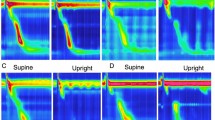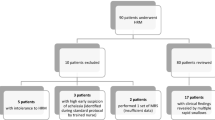Abstract
Background Conventional esophageal manometry evaluating liquid swallows in the recumbent position measures pressure changes at a limited number of sites and does not assess motility during solid swallows in the physiologic upright position. Aim To evaluate esophageal motility abnormalities during water and bread swallows in the upright and recumbent positions using high-resolution manometry (HRM). Methods Thirty-two-channel HRM testing was performed using water (10 ml each) and bread swallows in the upright and recumbent positions. The swallows were considered normal if the distal peristaltic segment >30 mmHg was >5 cm, ineffective if the 30-mmHg pressure band was <5 cm, and simultaneous if the onset velocity of the 30 mmHg pressure band was >8 cm/s. Abnormal esophageal manometry was defined as the presence of ≥30% ineffective and/or ≥20% simultaneous contractions. Results The data from 96 patients (48 F; mean age 51 years, range 17–79) evaluated for dysphagia (56%), chest pain (22%), and gastroesophageal reflux disease (GERD) symptoms (22%) were reviewed. During recumbent water swallows, patients with dysphagia, chest pain, and GERD had a similar prevalence of motility abnormalities. During upright bread swallows, motility abnormalities were more frequent (p = 0.01) in patients with chest pain (71%) and GERD (67%) compared to patients with dysphagia (37%). Conclusions Evaluating bread swallows in the upright position reveals differences in motility abnormalities overlooked by liquid swallows alone.



Similar content being viewed by others
References
Nagler R, Spiro HM (1960) Esophageal motility studies in the clinical diagnosis of esophageal disease. Conn Med 24:1–7
Murray JA, Clouse RE, Conklin JL (2003) Components of the standard oesophageal manometry. Neurogastroenterol Motil 15:591–606
Pandolfino JE, Kahrilas PJ (2005) AGA technical review on the clinical use of esophageal manometry. Gastroenterology 128:209–224
Sears VW Jr, Castell JA, Castell DO (1990) Comparison of effects of upright versus supine body position and liquid versus solid bolus on esophageal pressures in normal humans. Dig Dis Sci 35:857–864
Kaye MD, Wexler RM (1981) Alteration of esophageal peristalsis by body position. Dig Dis Sci 26:897–901
Tutuian R, Elton JP, Castell DO, Gideon RM, Castell JA, Katz PO (2003) Effects of position on oesophageal function: studies using combined manometry and multichannel intraluminal impedance. Neurogastroenterol Motil 15:63–67
Howard PJ, Maher L, Pryde A, Heading RC (1991) Systematic comparison of conventional oesophageal manometry with oesophageal motility while eating bread. Gut 32:1264–1269
Holloway RH, Tippett MD, Horowitz M, Maddox AF, Moten J, Russo A (1999) Relationship between esophageal motility and transit in patients with type I diabetes mellitus. Am J Gastroenterol 94:3150–3157
Allen ML, Orr WC, Mellow MH, Robinson MG (1988) Water swallows versus food ingestion as manometric tests for esophageal dysfunction. Gastroenterology 95:831–833
Freeman J, Hila A, Castell DO (2004) Esophageal manometry. In: Castell DO, Richter JE (eds) The esophagus, 4th edn. Lippincott Williams & Wilkins, New York, pp 115–134
Meyer GW, Gernhardt DC, Castell DO (2000) Peristaltic pressure profiles of the human esophagus. J Clin Gastroenterol 30:270–273
Fox M, Hebbard GS, Janiak P, Brasseur JG, Ghosh S, Thumshirn M, Fried M, Schwizer W (2004) High-resolution manometry predicts the success of oesophageal bolus transport and identifies clinically important abnormalities not detected by conventional manometry. Neurogastroenterol Motil 16:533–542
Schwizer W, Thumshirn M, Dent J, Guldenschuh I, Menne D, Cathomas G, Fried M (2001) Helicobacter pylori and symptomatic relapse of gastro-oesophageal reflux disease: a randomised controlled trial. Lancet 357:1738–1742
Spechler SJ, Castell DO (2001) Classification of oesophageal motility abnormalities. Gut 49:145–151
Ghosh SK, Janiak P, Schwizer W, Hebbard GS, Brasseur JG (2006) Physiology of the esophageal pressure transition zone: separate contraction waves above and below. Am J Physiol Gastrointest Liver Physiol 290:G568–G576
Ghosh SK, Pandolfino JE, Zhang Q, Jarosz A, Shah N, Kahrilas PJ (2006) Quantifying esophageal peristalsis with high-resolution manometry: a study of 75 asymptomatic volunteers. Am J Physiol Gastrointest Liver Physiol 290:G988–G997
Tutuian R, Castell DO (2004) Clarification of the esophageal function defect in patients with manometric ineffective esophageal motility: studies using combined impedance-manometry. Clin Gastroenterol Hepatol 2:230–236
Johnston BT, Collins JS, McFarland RJ, Blackwell JN, Love AH (1993) A comparison of esophageal motility in response to bread swallows and water swallows. Am J Gastroenterol 88:351–355
Pouderoux P, Shi G, Tatum RP, Kahrilas PJ (1999) Esophageal solid bolus transit: studies using concurrent videofluoroscopy and manometry. Am J Gastroenterol 94:1457–1463
Author information
Authors and Affiliations
Corresponding author
Additional information
This work was presented as an abstract at Digestive Disease Week (DDW) 2006, Los Angeles, CA, 20–25 May 2006.
Rights and permissions
About this article
Cite this article
Bernhard, A., Pohl, D., Fried, M. et al. Influence of Bolus Consistency and Position on Esophageal High-Resolution Manometry Findings. Dig Dis Sci 53, 1198–1205 (2008). https://doi.org/10.1007/s10620-007-0014-z
Received:
Accepted:
Published:
Issue Date:
DOI: https://doi.org/10.1007/s10620-007-0014-z




